Thermal insulation is necessary to protect your home from uncomfortable weather and to keep energy costs under control, whether it’s winter or summer. However, not all insulation materials work the same way. If you’re wondering which type of insulation is right for you, today we’re comparing cellulose vs fiberglass insulation.
There is a large variety of insulation materials. In besides the type of material, they can be divided by location of use (wall cavities, floor, ceiling, pipes, or attic), and by form (foam, loose filler, blown-in insulation, panels). We are going to talk about each type of insulation and then make a comparative table of pros and cons.
So, let’s weigh cellulose vs fiberglass. Dive in for more details!
Fiberglass Insulation: Main Properties
Everyone has probably seen the fluffy pink piles in the attic – that’s what fiberglass insulation is. It is deservedly one of the most common insulation materials. It is good in both heat and cold, long lasting and environmentally friendly. Also, this insulation material can be called cost-effective, as the cost starts at $0.40 per square foot.
Fiberglass insulation is made from molten glass that is spun or blown into fibers. Most manufacturers use up to 40% to 60% recycled glass content.
The thickness of the insulation layer determines the R-value, so fiberglass is suitable for every climate zone. Typically, blown fiberglass insulation in attics has an R-value of 2.5 per inch. Note that this is in height, not area. So, the final insulation R-values depend on the layer you make.
What fiberglass insulation looks like
In the 2030s, fiberglass insulation will be 100 years old. During that time, the process of its manufacture has not changed much, although it has improved. After recycled glass melts, tiny fibers are formed, tangled into a puffy mass.
To hold the fibers together, a resin-based binder is used. This adhesive determines the color of the fiberglass insulation. In addition to pink, fiberglass is also available in white, green, and brown. The color doesn’t make much difference, more often than not, it just defines the manufacturer.
Moving along the conveyor belt, the glass insulation can be packaged in vacuum bags or formed into batts of desired thickness and size. For attic insulation, fiberglass is used in the form of batts and loose-fill fiberglass.
Fiberglass batt insulation material
Fiberglass batts are rolls of fiberglass insulation that just need to be rolled out over the attic floor. Installing fiberglass insulation in rolls is great to do-it-yourself. Fiberglass batts are often used for wall insulation because this material holds its shape well and is easy to attach.
Batts are handy for calculating how much insulation you will need. Each roll contains coverage for a certain area. All you have to do is divide the area of your attic by the area of the roll. This gives you how much batt insulation you need to buy.
The only drawback with fiberglass batts is that they are difficult to lay around pipes, air ducts, corners, and other utilities. But loose-fill insulation does a great job with that.
By the way, air duct maintenance requires adequate insulation. Open the link to the post in a new tab so you don’t lose it.
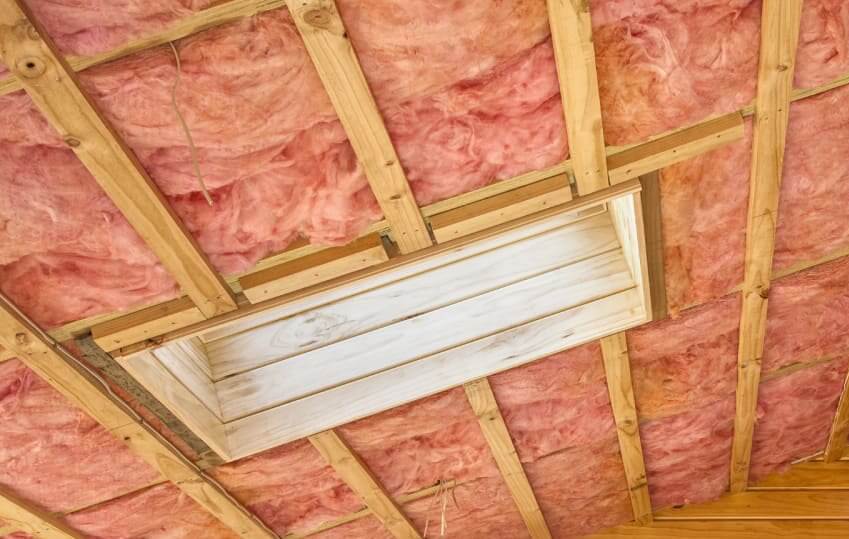
Loose-fill fiberglass material
Loose-fill insulation is practical because it does not require crating or fasteners. Glass fibers fill the entire attic volume in an even layer. To do everything properly, it is better to invite professionals who have special blowing machine.
Loose-fill fiberglass insulation is very volatile and can rise into the air by any careless movement. To ensure that the layer of insulation does not settle and move over time, do not hesitate to purchase an attic measuring ruler. The insulation contractor will always offer it, but there’s nothing stopping you from buying the ruler from Amazon yourself.
If you’re up to a do-it-yourself project, it’s a good idea to look out for a mesh layer over fiberglass. Such a mesh will keep the blown fiberglass insulation from traveling around the attic with every air movement.
Blown-in fiberglass insulation on the attic floor combines well with radiant barrier insulation on the roof slopes and ceiling. This stuff is not involved in the heat transfer, but reflects it.
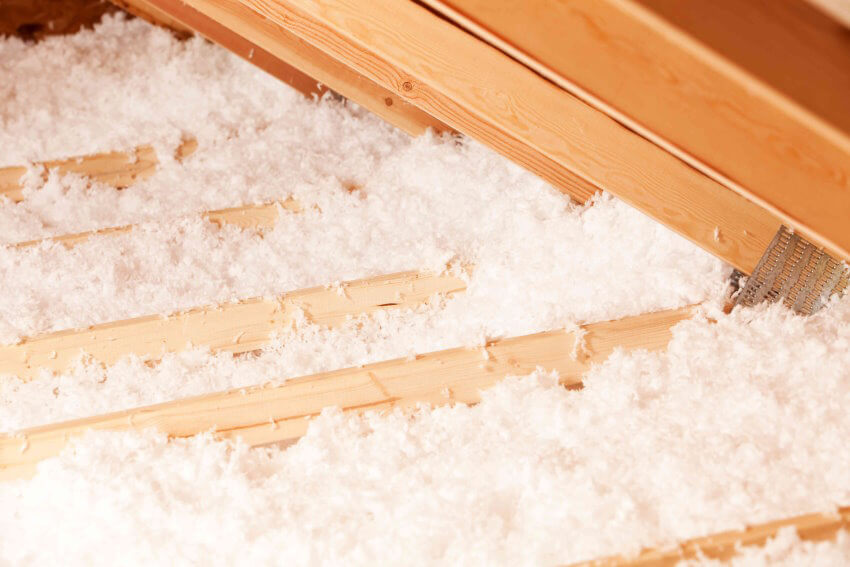
What Cellulose Insulation Material Is
Cellulose insulation is a common material for attic construction. It is relatively inexpensive and is used in new construction projects as well as in existing houses.
Cellulose insulation is made from recycled paper products, primarily newsprint, and has a very high recycled material content, generally 82% to 85%.
Made of recycled paper products, pieces of denim and others fabric, small wood chips, cellulose insulation has grey color. After processing into fiber, the cellulose material is treated with a fire retardant and insect and vermin repellent.
The R-value of loose cellulose is, on average, 3.5 per inch. Achieving the R-value you want is governed by the thickness of the layer.
How cellulose insulation is used
Cellulose has been valued since about the 1950s as an energy-efficient and eco-friendly material. This loose insulation material is suitable for attics of all shapes and designs. Tiny pieces of cellulose fill the entire volume offered, penetrating all nooks, crannies, and wall cavities.
Cellulose insulation can be a blown-in material. Also you can get wet-spray cellulose with water in its composition. In any case, it is better to entrust the cellulose insulation project to professionals.
However, sometimes an insulation contractor provides his insulation blowing machine for rent. Installing cellulose insulation is really not the easiest do-it-yourself project, but the thought of saved costs and reduced energy bills will help you get by. Look out for a post on renting this equipment, stay tuned.
There are three forms of attic cellulose insulation: blown-in, wet-applied, and packed.
Loose-fill cellulose insulation
Loose-fill cellulose is similar to fiberglass loose-fill insulation. It also takes up the entire attic floor, covering all the gaps and crevices with a thick gray layer.
The difference is that cellulose is based on paper recycled material, so it is vulnerable to dampness. For dampness resistance boric acid is used, which is a harmless chemical for humans even if it gets into the living space. But without it, the paper would not be moisture resistant and would be a great breeding ground for mold and bugs.
Loose-fill insulation is only used for the floor as it has no mounting. This insulation type is used for renovation of existing buildings and new insulation projects. Professionals usually use air blowing through the entrance to the attic or through a hole in the roof.
Do-it-yourself enthusiasts can use rental equipment or carry bags upstairs by hand. The average cost of this insulation material starts at $0.80 per square foot.
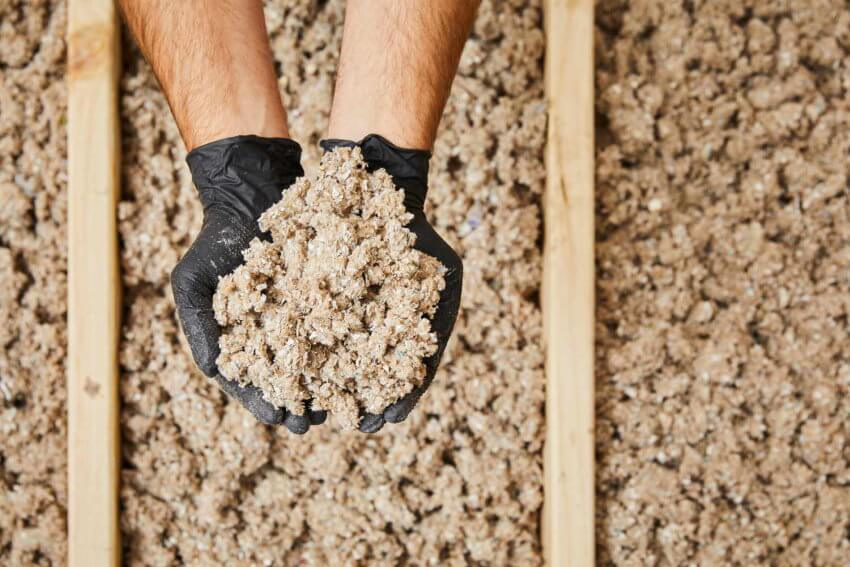
Wet-spray cellulose insulation
Wet-applied cellulose is somewhat similar to foam insulation. Just before application, water and adhesives are added to the cellulose. The mixture is sprayed onto walls and other structures.
After drying, it forms a durable surface that reliably protects against extreme cold and heat. Covering all small cracks and crevices in a wall cavity, wet cellulose does not guarantee absolute air sealing.
Air leakage from the outside should be caulked in advance. But usually this problem does not arise, since this type of cellulose insulation is used in new buildings when the drywall has not yet been laid.
The initial price of spray cellulose starts at $1.25. These jobs are the kind of thing you’ll have to trust professionals with, since special equipment and skills are required.
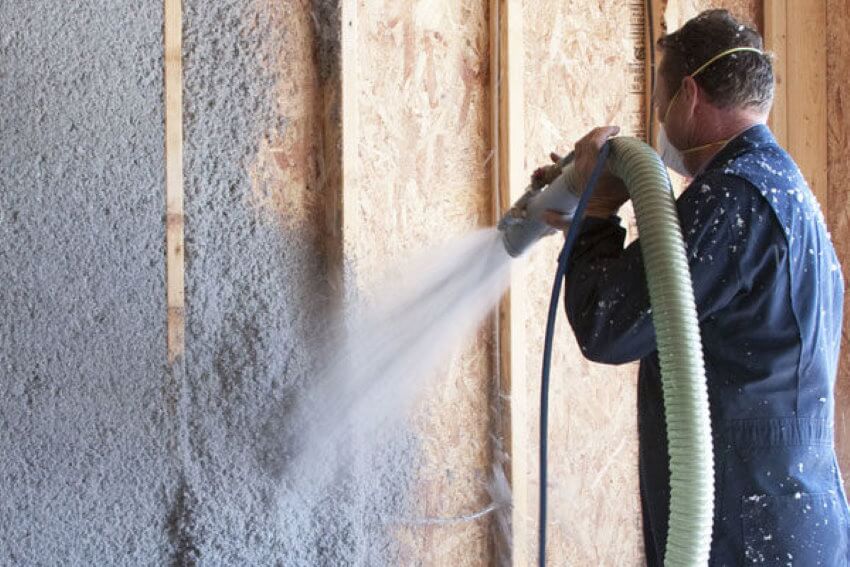
Dense-packed cellulose insulation
Invented in 2005, dense-packed cellulose is a system for insulating exterior walls of buildings. Dense cellulose is similar in form to mineral wool batt insulation. It is laid during the construction of walls, making a sandwich filling through which no cold or heat flow passes.
If you’re planning to build a new house, dense-packed cellulose system is something you want to take a closer look at. This insulation material has the potential to make construction cheaper and reduce your future energy bill.
As an option, dry cellulose is blown into a net, and the net is already attached to the desired wall or attic location. The packing prevents the cellulose insulation from scattering by careless movements or drafts.
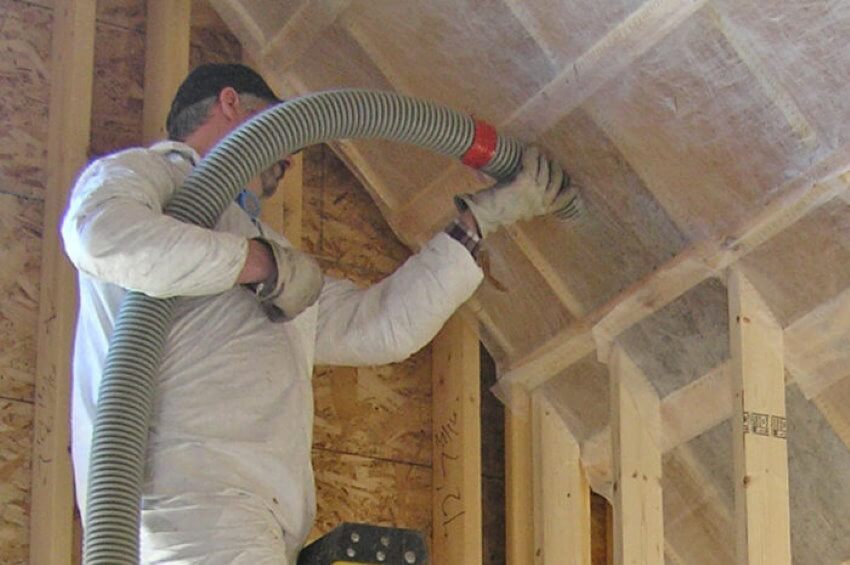
What Type of Insulation to Choose
Knowing what choices are available, let’s compare them based on a few key indicators. As a result, let’s group the table to make it more convenient.
Fiberglass and cellulose insulation: Thermal performance
Comparing the two types of insulation, thermal performance is where we should get started. Here we have gathered not only the above mentioned cellulose and fiberglass insulation, but other types of insulation as well. R-value data are based on the materials of the Department of Energy and Housing and Urban Development.
Note, R-values are measured per inch of thickness, not per square inch of area.
| Insulation Type | R-value per Inch of Thickness |
| Fiberglass blanket or batt | 3.2 |
| High performance fiberglasss batt | 3.8 |
| Loose-fill fiberglass | 2.5 |
| Loose-fill rock wool | 2.8 |
| Loose-fill cellulose | 3.5 |
| Dense-pack cellulose | 4.0 |
| Expanded polystyrene board | 3.8 |
| Extruded polystyrene board | 4.8 |
| Polyisocyanurate board, unfaced | 5.8 |
| Polyisocyanurate board, foil-faced | 7.0 |
| Spray polyurethane foam | 5.9 |
As known, the higher R-value, the better thermal resistance. Accordingly, the higher the R-value, the higher the cost of the insulating material. The final choice depends on the climate zone in which you live and the project you are planning.
Weighing fiberglass and cellulose insulation, it’s obvious that cellulose has a higher R-value than glass fibers. Dry, loose and friable paper fibers hardly transfer heat through them. But as soon as they get wet or compacted, their heat transfer performance will deteriorate.
So whether you choose fiberglass or cellulose insulation, seal your attic well in advance.
Fiberglass insulation or cellulose: Budget planning
Understanding your upcoming costs is very important to follow through. Yes, you’ve read about the cost of insulation material per sq.ft. But to calculate the cost of the project, you have to go deeper.
You’ve already looked up your zip code to what your target R-value is, haven’t you? Now calculate how many inches of coverage you need to achieve it. Fiberglass is cheaper, but you’ll need more of it because it has less R-value.
At this point, you’ll benefit from sample attic insulation calculation . There’s not only blown-in paper and fiberglass insulation, but also foam materials.
Fiberglass or cellulose: Eco-friendliness
Both fiberglass and paper insulation are environmentally friendly products. Fiberglass is made from sand and glass, and the percentage of recycled glass is steadily increasing. Paper insulation is made mainly from recycled newspapers.
Interestingly, the very fact that you use insulation in your home is a green thing as well. Saving on your utility bills is your contribution to the wise consumption of our planet’s resources.
Fiberglass insulation vs cellulose insulation: Potential risks
Both cellulose and fiberglass insulation have some potential risks. Liquid spray aside, both these insulation types have microfibers that easily rise into the air and can be inhaled.
Also, fiberglass tends to be prickly, not sharp enough to injure the skin, but enough to leave redness and itching. Paper insulation, on the other hand, is treated with chemicals and tends to produce dust.
Always take safety precautions when working with insulation materials or just going up in the attic. Wear long sleeves, gloves, closed shoes, and a dust mask to protect your respiratory system. Beware of children and pets from playing in the attic, it can be really dangerous for those of small height.
Cellulose vs fiberglass insulation: Pros and cons
| Comparable indicator | Fiberglass insulation | Cellulose insulation |
| R-value | 2.5 – 3.8 | 3.5 – 4.0 |
| Cost per square foot | Starts at $0.40 per square foot | Starts at $0.80 per square foot |
| Project costs | The cost of your project is calculated individually | Also requires individual calculation |
| Product type | Batts for walls and floor; loose-fill for attic floor | Loose-fill for attic floor |
| Installation complexity |
|
|
| Elimination of air leaks |
|
|
| Environmental impact | Manufactured from glass recycled material | Manufactured from recycled paper material |
| Useful properties |
|
|
| Potential hazards | Loses energy efficiency at extreme temperatures |
|
Fiberglass or Cellulose: Finally
Home insulation is an important issue that needs to be treated thoughtfully. The decision you make will determine your home’s energy efficiency for years to come. But in any case, any kind of insulation is better than nothing!
When in doubt Cellulose vs Fiberglass Insulation, watch this video:
